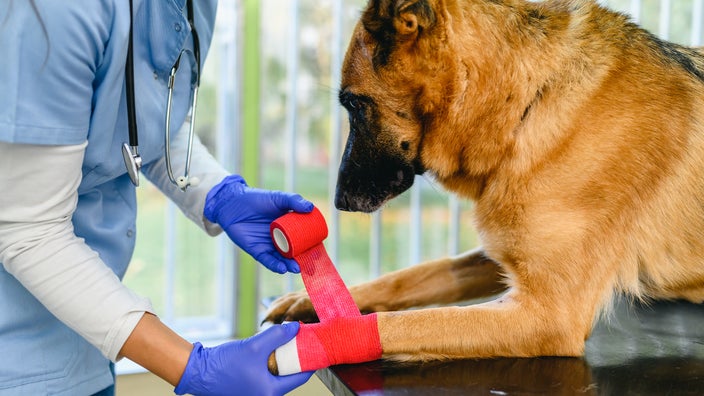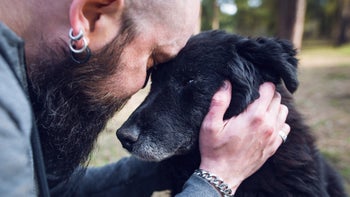
How Much Does ACL (CCL) Surgery for Dogs Cost?
Key takeaways:
Cranial cruciate ligament (CCL) surgery for dogs can cost between $750 and $8,000, but the procedure averages $2,000 to $4,000.
The CCL in dogs is the same as the anterior cruciate ligament (ACL) in humans. Surgery to repair this ligament in dogs may be called ACL or CCL surgery. And the cranial cruciate ligament is sometimes abbreviated as CrCL, instead of CCL.
Dog ACL/CCL surgery may be covered by some pet insurance plans. You may also be able to access financing options and free or low-cost care to make your dog’s procedure more affordable.
Table of contents

The cranial cruciate ligament (CCL) stretches over a dog’s knee and is sometimes abbreviated as CrCL. In humans, this band of tissue is called the anterior cruciate ligament (ACL). The ACL/CCL works like a strong rubber band that stabilizes the knee by preventing too much movement between the shin bone, or tibia, and the thigh bone, known as the femur.
ACL/CCL injuries in dogs do not always require surgery. But untreated injuries can lead to permanent pain, arthritis, and lameness.
If your dog’s ACL/CCL needs surgery, you may be facing thousands of dollars in costs. These procedures usually range from $750 to $8,000 depending on the surgery technique and other factors.
Save on the top 10 pet medications
Save big on common pet medications like Fluoxetine and Levetiracetam at your local pharmacy.

GoodRx is NOT insurance. GoodRx Health information and resources are reviewed by our editorial staff with medical and healthcare policy and pricing experience. See our editorial policy for more detail. We also provide access to services offered by GoodRx and our partners when we think these services might be useful to our visitors. We may receive compensation when a user decides to leverage these services, but making them available does not influence the medical content our editorial staff provides.
What is ACL surgery for dogs?
ACL surgery for dogs is an operation that repairs a ruptured or torn CCL. When a dog’s CCL gets damaged, the knee joint becomes unstable. This causes the dog pain and makes it difficult for them to walk. And surgery is often needed to correct the damage.
Having surgery as quickly as possible will prevent your dog from having a permanent disability and reduce their risk of secondary arthritis.
What are the different types of ACL/CCL surgeries for dogs?
There are several ways to repair a dog’s torn CCL. But all of the approaches involve one of three main techniques, which are outlined in the chart below.
| Dog ACL/CCL surgery technique | Treatment approach |
|---|---|
| Suture-based |
|
| Bone-reshaping |
|
| Implant-based |
|
Each type of procedure has unique benefits and risks. Your dog’s surgery options will depend on factors, such as:
Extent of injury
Shape of leg bones
Surgery techniques explained
Your surgeon will examine your dog and give you a procedure recommendation. Here’s more about each surgery technique.
Suture-based
Suture-based surgical techniques like ELSS and the TightRope technique are the most affordable and least invasive. These procedures use extra strong sutures designed to create supportive scar tissue in key places. The strength of the sutures stabilizes the dog’s knee while it heals. And then, scars form along the suture lines and continue to reinforce the area.
Suture techniques have a long history of use and are very effective. Recovery involves around 6 to 8 weeks of restricted movement and physical therapy.
Read more like this
Explore these related articles, suggested for readers like you.
Bone-reshaping
Bone-reshaping surgical techniques include TPLO, TTA and TTO. In these surgeries, the top of the shinbone is cut and then reshaped to support the dog’s knee joint. This provides stability to the knee and protects the injured ligament. These procedures are more invasive but they have excellent long-term success. Expect up to 6 months of restricted movement and physical therapy after surgery.
TPLO is the most common ACL/CCL technique overall because of its success rate for the most common population that suffers ACL/CCL ruptures.
Implant-based
At the time of publication, implant-based CCL repair is a developing technology. It is slightly more invasive than suture-based techniques, but less invasive than bone-reshaping surgeries.
What is the average cost of dog ACL/CCL surgery?
Depending on the procedure, the cost of dog ACL/CCL surgery ranges from $750 up to $8,000. But the average cost ends up at $2,000 to $4,000.
You may receive a bundled price from your veterinary surgeon that includes the surgery and additional services. The chart below shows ACL/CCL procedure estimates for surgery only. These prices do not include:
Anesthesia
Follow-up visits
Medications
Physical therapy
X-rays
| Surgery technique | Treatment approach | Average price per knee |
|---|---|---|
| Suture-based | Extracapsular lateral suture stabilization (ELSS) | $750-$1,000 |
| TightRope Technique | $1,000-$2,000 | |
| Bone-reshaping | Tibial plateau leveling osteotomy (TPLO) | $3,000-$8,000 |
| Tibial tuberosity advancement (TTA) | $3,000-$6,000 | |
| Triple tibial osteotomy (TTO) | $3,000-$6,000 | |
| Implant-based | Price estimates are not widely available because this is a developing technology. The estimates are comparable to those for TPLO and TTA, which costs $3,000-$8,000. |
How can you find the best price for ACL/CCL surgery for your dog?
The best way to save money on dog ACL/CCL surgery is to shop around. Here are some tips to help you find the best price:
Call local veterinarians and compare prices. Veterinary offices offer different prices for procedures. Calling around can help you understand the price per service compared to bundled offers for your dog’s procedure. You can also ask about financing options.
Contact rural or small town veterinarians in less expensive areas. The costs of veterinary services can vary widely from place to place. You may find a better deal by traveling to a nearby area that offers more affordable prices.
Check your pet insurance to see if this surgery is covered. If you have pet insurance, dog ACL/CCL surgery may be covered, depending on your plan. Insurance coverage can reduce your out-of-pocket costs. Some pet health insurance plans do not pay the full amount of the surgery, but will reimburse you for a portion of the cost. Check with your pet insurance company to confirm your plan’s benefits.
Is there financing available for pet surgery?
There are many ways to finance pet surgery. Here are some of the most common:
Vet financing: Some veterinarians partner with financing companies to offer payment arrangements for your pet’s healthcare costs. These plans often do not require a credit check and have a 100% approval rate. If you have less than perfect credit, this is your best option. Find a veterinarian in your area who offers a financing program.
Care Now, Pay Later: This financing option lets you pay your veterinary bills in installments. Your Care Now, Pay Later interest rate is determined by your credit score.
Medical credit card: You can only use medical credit cards at participating veterinary offices for your pet’s healthcare needs. You may be better off opening a traditional card with a 0% interest rate or a rewards credit card instead. Interest rates are determined by your credit score.
Medical loans: These are basically personal loans that can only be used for medical care. You will need good or excellent credit to qualify for a medical loan to pay veterinary bills.
Personal loans: Personal loans can be used for any reason, including for your dog’s healthcare costs. There are more personal loan options on the market than medical loan options. You will need good or excellent credit to qualify.
Avoid applying for multiple loans at once. Research your options and compare terms, then apply for one financing option. Multiple credit applications could trigger a series of inquiries on your credit report. Those inquiries could drop your credit score, even if you secure financing.
What can you do if you can’t afford ACL surgery for your dog?
If you can’t afford ACL surgery for your dog, here are some ways to access free or low-cost veterinary care:
Ask about discounts. Some veterinarians provide charity care or offer discounts. Call your veterinarian and explain your situation. If they can’t help you, ask them to refer you to a veterinary office or organization who may be able to offer assistance.
Contact nonprofit organizations. Local nonprofits that offer free vaccinations and other free and low-cost vet care might be able to help you pay for your dog’s ACL surgery or tell you about other options.
Contact veterinary medicine colleges. Many vet schools run low-cost clinics for pet owners with limited resources. You can find a list of accredited veterinary colleges and their contact information here.
You can also explore options available from organizations that help with vet bills.
Can a dog live comfortably without having ACL surgery?
As mentioned earlier, untreated ACL/CCL injuries can lead to permanent pain, arthritis, and lameness in dogs. But surgery is not always required for your dog to live comfortably. Sometimes, minor injuries can be treated successfully with rest, anti-inflammatory medications, knee braces, and physical therapy.
A veterinarian can determine whether your dog needs to have ACL/CCL surgery.
The bottom line
The cranial cruciate ligament (CCL) in dogs is the same as the anterior cruciate ligament (ACL) in humans. ACL/CCL injuries in dogs are common and typically require surgery.
Dog ACL/CCL surgery prices range from $750 to 8,000, but average $2,000 to $4,000. The final price will depend on your dog’s injury and the repair procedure performed. Dog ACL/CCL surgery may be covered by some pet insurance plans. Or you may be able to access financing options, low-cost care, or free services to make your dog’s procedure more affordable.
Why trust our experts?



References
American Veterinary Medical Association. (n.d.). Accredited veterinary colleges.
Axelton, K. (2020). How long do hard inquiries stay on your credit report? Experian.
Bergh, M. S., et al. (2014). Systematic review of surgical treatments for cranial cruciate ligament disease in dogs. Journal of the American Animal Hospital Association.
Best Friends Veterinary Center. (n.d.). ACL repair choices.
Bruce, W. J., et al. (2007). Evaluation of the triple tibial osteotomy. A new technique for the management of the canine cruciate-deficient stifle. Veterinary and Comparative Orthopaedics and Traumatology.
Christopher, S. A., et al. (2015). Comparison of long-term outcomes associated with three surgical techniques for treatment of cranial cruciate ligament disease in dogs. Veterinary Surgery.
Cook, J. L. (2010). Cranial cruciate ligament disease in dogs: Biology versus biomechanics. Veterinary Surgery.
Cook, J. L., et al. (2010). Clinical comparison of a novel extracapsular stabilization procedure and tibial plateau leveling osteotomy for treatment of cranial cruciate ligament deficiency in dogs. Veterinary Surgery.
De La Cruz, K. (2021). Does a dog’s size impact surgery success for cruciate ligament repair? Dog Knee Injury.
DeNicola, L. (n.d.). What is a good credit score? Experian.
Dog Knee Injury. (n.d.). Simitri Stable in Stride.
Fitzpatrick Referrals. (n.d.). Cruciate ligament disease or injury.
Griffith, C. J., et al. (2011). Outcomes of untreated posterolateral knee injuries: An in vivo canine model. Knee Surgery, Sports Traumatology, Arthroscopy.
iCare Financial. (n.d.). Veterinary financing assistance.
James L. Voss Veterinary Teaching School. (n.d.). Canine cruciate ligament injury. Colorado State University.
Johnson, T. A., et al. (2022). Outcome of cranial cruciate ligament replacement with an enhanced polyethylene terephthalate implant in the dog: A pilot clinical trial. Veterinary Surgery.
Leicht, K. (2022). ACL surgery in dogs: Costs & healing treatments. K9 of Mine.
MetLife Pet Insurance. (2022). How much does dog ACL surgery cost? What is it and what to expect.
Mortensen, C. (2023). How much does dog ACL surgery cost? 2023 update. Pet Keen.
Nanda, A., et al. (2019). Tibial plateau leveling osteotomy for cranial cruciate ligament rupture in canines: Patient selection and reported outcomes. Veterinary Medicine: Research and Reports.
Pal, M. (2023). How much does ACL surgery for dogs cost? (2023 guide). Forbes Advisor.
Progressive. (n.d.). How does pet insurance work for surgeries?
Racine, E. (2022). Dog ACL (CCL) surgery cost and financing options. Care Credit.
TopDog Health. (n.d.). TightRope surgery for dogs.
VanSomeren, L., et al. (2020). Medical loans: What they are & how to get one. Forbes Advisor.



























